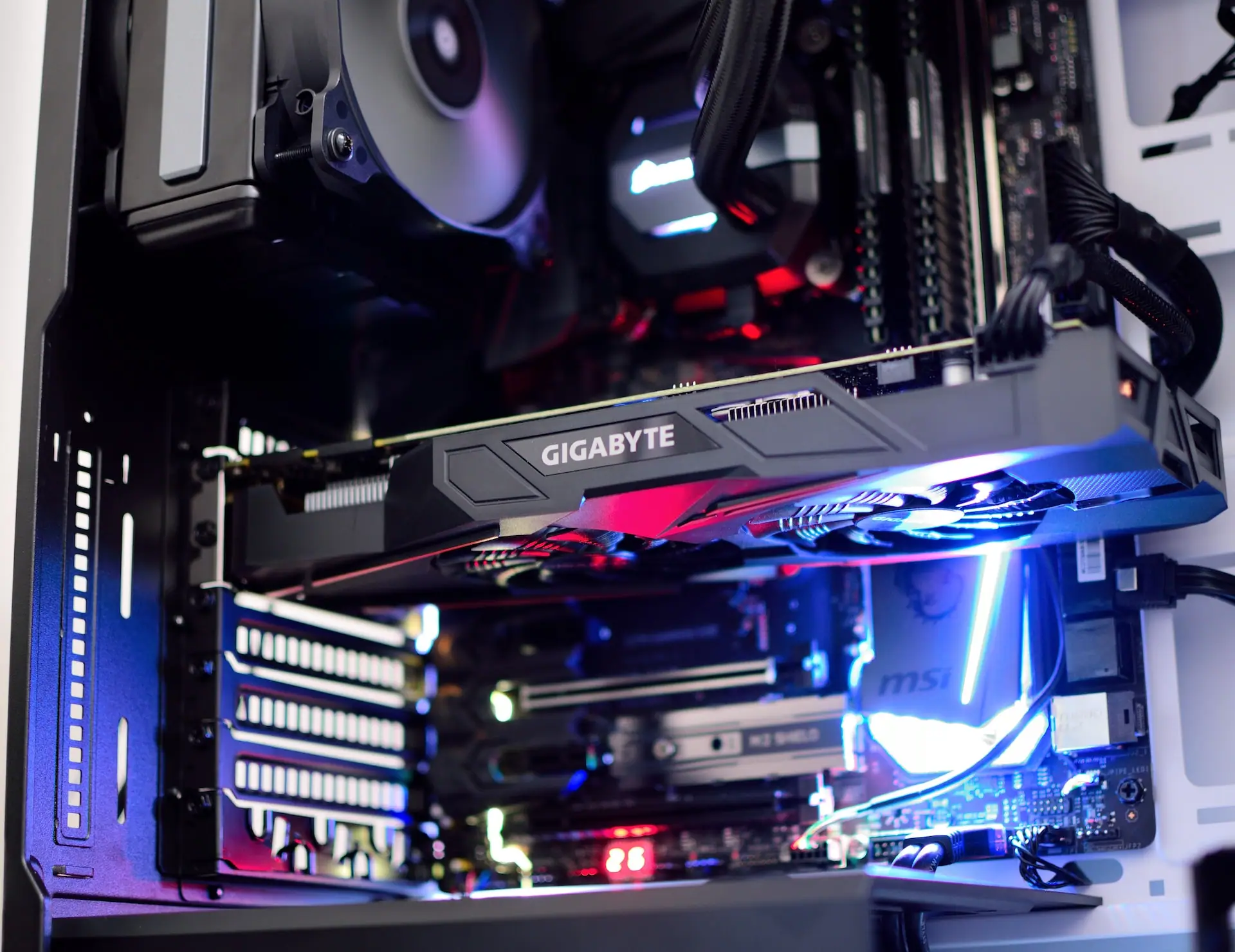
The Best 4K Graphics Card in 2024
When it comes to gaming PCs, it is widely acknowledged that the most crucial component is the graphics card. Serving as the beating heart of the system, it is the graphics card that truly sets the stage for an immersive gaming experience. While other components certainly play a role, they pale compared to the paramount importance of a top-notch graphics card. To achieve optimal performance, it is crucial to have a robust graphics processing unit (GPU) that can effectively handle the rendering of pixels.
Even if you possess the most high-speed central processing unit (CPU) available, its capabilities will be limited without a powerful GPU to support it. When selecting a graphics card, it’s essential to consider that there isn’t a one-size-fits-all solution.
Top 4 Best 4K Graphics Cards in 2024
1. MSI NVIDIA GeForce RTX 4090 Card
The NVIDIA GeForce RTX 4090 graphics card is anything but subtle. The graphics card in question is an impressive and robust piece of technology, boasting a substantial presence. Although it shares some similarities with the design of the RTX 3090 shroud, there are notable additions in the form of sleek curves that prevent it from being a mere replica. This results in a visually striking graphics card with novelty and uniqueness.
The product is a cleverly designed plastic model that serves as a satirical commentary on the growing dimensions of graphics processing unit (GPU) cards. However, this remarkable creation is far from a mere model or a moon. It stands at the forefront of the entire RTX 40-series GPU generation, offering us a tantalizing glimpse into the groundbreaking Ada Lovelace architecture.
On the one hand, the introduction showcases the remarkable capabilities of Ada in delivering unparalleled performance when given ample freedom. On the other hand, it is essential to acknowledge that the timing of this release may seem somewhat insensitive, considering the current global economic crisis. Launching a graphics card targeted at a select group of affluent gamers may appear somewhat out of touch with the prevailing circumstances.
However, we must acknowledge the significance of the RTX 4090 in our comprehensive review of the top GPUs available. At the moment, no other option can match the exceptional performance this remarkable graphics card delivers. The AMD RX 7900 XTX, the epitome of cutting-edge technology, stands poised to dominate the market, firmly establishing itself as a formidable contender against the renowned RTX 4080. With its unparalleled performance and unwavering momentum, this graphics card is set to maintain its position at the forefront of innovation.
Specification:
- Graphics Coprocessor: NVIDIA GeForce RTX 4090
- Brand: MSI
- Graphics Ram Size: 24 GB
- GPU Clock Speed: 2.61 GHz
- Video Output: Interface DisplayPort, HDMI
Reasons To Buy
+ Excellent gen-on-gen performance
+ Excellent gen-on-gen performance
+ Super-high clock speeds
Reasons To Avoid
– Massive
– Ultra-enthusiast pricing
2. Radeon RX 7900 XTX Graphic Card

The highly anticipated arrival of the AMD Radeon RX 7900 XTX in late 2024 brought with it a significant challenge: to establish itself as the leading gaming GPU under the $1,000 price point. Fortunately, this formidable graphics card not only meets this expectation but surpasses it with flying colors. It outshines Nvidia’s RTX 4080, a competitor priced 20% higher in terms of overall performance.
The cutting-edge 2nd-generation ray accelerators in the remarkable RX 7900 XTX revolutionize the gaming experience by enabling seamless 4K gameplay on ultra settings, complete with the immersive realism of ray tracing. This remarkable feat sets the AMD card apart from its predecessor, the RX 6950 XT, as it surpasses the previous boundaries and delivers an unparalleled level of performance.
While the graphics card does have its share of imperfections, such as lagging behind the Nvidia RTX 4000-series in ray tracing capabilities (although it does surpass the Nvidia RTX 3090 in terms of RT performance) and exhibiting inconsistent performance with specific creative workloads, it remains the top choice for individuals seeking to upgrade their GPU after enduring prolonged graphics card shortages.
Specification:
- Graphics Coprocessor: AMD RX 7900 XTX
- Brand: XFX
- Graphics Ram Size: 24 GB
- GPU Clock Speed: 2615 MHz
- Video Output Interface: DisplayPort, HDMI
Reasons To Buy
Reasons To Avoid
– Much slower RT performance
3. Radeon RX 6600 Graphics Card
Best Overall Value
The Radeon RX 6600 encapsulates all the impressive features of its predecessor, the 6650 XT while making subtle adjustments to enhance its overall performance. With a slight performance advantage, the RTX 3050 surpasses its counterpart by a mere margin, clocking in at approximately 20% slower overall.
This disparity becomes even more apparent when considering DXR games, where the RTX 3050 barely outperforms its competitor. When considering the remarkable hardware capabilities of the Discount DXR, it becomes evident that this device surpasses the 3050 by a significant margin, boasting an impressive 25% increase in speed.
While it may fall slightly behind the RTX 3060 and Arc A750, the Discount DXR still holds its ground as a formidable contender in high-performance graphics cards. While it is undeniable that the performance of the new RTX 4060 surpasses that of this particular product, it is essential to consider the significant cost difference. With a price tag over $100 lower, this slight decrease in speed can be deemed acceptable.
With prices plummeting to an astonishingly affordable $179, this option has become an irresistible choice for those seeking a wallet-friendly alternative. At its release, AMD’s initial price point of $329 was perceived as relatively steep. However, in light of the decline in Ethereum mining activities, the market has become saturated with an abundance of midrange GPUs.
For those who may not find themselves captivated by the latest offerings in the realm of GPUs from AMD and Nvidia and instead seek a reliable and satisfactory mainstream solution, look no further than this exceptional choice.
The realm of midrange graphics cards is a fiercely contested battleground, and the RX 6600 finds itself in direct competition with not only the recently discounted RTX 3050 but also the previous generation RTX 20-series GPUs. In our comprehensive evaluation, the performance of this product closely rivals that of the esteemed RTX 2070, particularly in situations where ray tracing is not a factor. When ray tracing is enabled, the system’s performance noticeably declines, struggling to maintain an average of 30 frames per second in our DXR test suite at 1080p medium settings.
Specification:
- Graphics Coprocessor: AMD Radeon RX 6600
- Brand: Sapphire Technology
- Graphics Ram Size: 8 GB
- GPU Clock Speed: 2491 MHz
- Video Output Interface: DisplayPort, HDMI, PCI Express
Reasons To Buy
Reasons To Avoid
4. Intel Arc A750 GPU

The Arc A750 presents users with a slightly streamlined variant of the powerful Arc A770 GPU, known as the G10. For a more comprehensive understanding of the G10 and its capabilities, I highly recommend delving into my detailed review of the Intel Arc A770. Featuring a robust configuration, the device boasts an impressive 28 Xe-cores, serving as the fundamental components of the cutting-edge Xe-HPG architecture.
It is worth noting that this count is only a slight deviation from the 32 Xe-cores found in the highly acclaimed Arc A770 model. In terms of performance, the mentioned device is not significantly behind the pace set by that particular card. However, it does operate at a slightly slower speed and possesses only half of the total memory capacity.
The memory specification of the Arc A750 is truly remarkable, especially considering its price point. The primary reason behind this observation is that Intel’s Arc A750 boasts an impressive level of graphical prowess that surpasses its price point. Intel made significant investments in the formidable specifications of its inaugural GPUs, boasting a unique memory capacity.
However, regrettably, the drivers fell short of Intel’s desired performance benchmarks. While it is true that certain games may not be fully compatible with the Arc A750, it is essential to note that this does not diminish the overall quality of the device. Despite these limitations, there are still numerous positive aspects to consider. Furthermore, the Arc A750 possesses a plethora of untapped potential.
Meanwhile, Intel, in collaboration with esteemed partners like ASRock, has taken a strategic approach by reducing the price of their cutting-edge Arc A750 graphics card. This move aims to create a competitive edge against AMD’s highly acclaimed RX 6600, thereby intensifying the battle for supremacy in the graphics card market.
Specification:
- Graphics Coprocessor: Intel Arc A750 GPU
- Brand: Intel
- Graphics Ram Size: 8 GB
- GPU Clock Speed: 2050 MHz
- Video Output Interface: DisplayPort
Reasons To Buy
Reasons To Avoid
Types of 4K Graphics Card in 2024
In 2024, the landscape of graphics cards offers a variety of options tailored to different gaming, design, and content creation needs. Here are the types of graphics cards to consider for powering your digital experiences:
Gaming Graphics Cards:
These cards are optimized for delivering high frame rates and exceptional visuals in gaming. They come in various tiers, from entry-level to enthusiast, offering a balance between performance and price.
Workstation Graphics Cards:
Designed for professionals in fields like 3D modeling, animation, and video editing, these cards provide specialized drivers and features to handle complex tasks and large datasets.
Content Creation Graphics Cards:
Tailored for content creators, these cards offer high-quality graphics performance and advanced video encoding capabilities for smooth editing and rendering.
AI and Machine Learning Graphics Cards:
With dedicated hardware for AI and machine learning tasks, these cards accelerate deep learning algorithms and data processing, enhancing research and development projects.
Compact Graphics Cards:
Compact or low-profile graphics cards are suitable for small form-factor PCs, offering decent gaming and performance capabilities while fitting into tight spaces.
External Graphics Cards (eGPUs):
These cards allow you to enhance your laptop’s graphics performance by connecting an external enclosure with a desktop graphics card, providing a gaming boost for portable systems.
Budget Graphics Cards:
Ideal for casual gamers or those on a tight budget, these cards provide acceptable gaming performance for popular titles without breaking the bank.
Multi-GPU Graphics Cards:
Some cards support multi-GPU configurations, allowing you to combine two or more cards for increased gaming or rendering performance.
Ray Tracing Graphics Cards:
These cards feature dedicated hardware for real-time ray tracing, which enhances lighting, reflections, and shadows in supported games.
VR-Ready Graphics Cards:
Built to provide smooth virtual reality experiences, VR-ready cards offer the necessary power and performance for immersive VR gaming and applications.
Silent Graphics Cards:
These cards prioritize quiet operation with efficient cooling solutions, making them suitable for media centers or environments where noise is a concern.
Entry-Level Graphics Cards:
Perfect for light gaming and everyday tasks, entry-level cards offer a cost-effective solution for users who don’t require high-end performance.
Overclocked Graphics Cards:
These cards come pre-overclocked by the manufacturer to deliver enhanced performance. They are suitable for users who want a performance boost without manual overclocking.
What To Look For While Buying The Best 4K Graphics Card in 2024
Performance:
Choose a graphics card that meets or exceeds the performance requirements of the tasks you intend to perform, whether gaming, video editing, or 3D rendering.
VRAM (Video Memory):
Higher VRAM capacity allows the graphics card to handle more complex textures and larger resolutions. Aim for a card with sufficient VRAM for your intended usage.
Compatibility:
Ensure the graphics card is compatible with your computer’s hardware, including the motherboard’s PCIe slot and power supply capacity.
Resolution and Refresh Rate:
If gaming, consider the monitor’s resolution and refresh rate. A higher-end graphics card is required for gaming at higher resolutions (such as 4K) and high refresh rates (such as 144Hz).
Ray Tracing and DLSS:
If interested in advanced graphics technologies, consider a card that supports real-time ray tracing and Deep Learning Super Sampling (DLSS) for enhanced visual fidelity.
Cooling Solution:
Opt for a graphics card with an efficient cooling solution, such as multiple fans or liquid cooling, to maintain optimal temperatures and prevent overheating.
Form Factor:
Ensure the graphics card fits within your computer case. Some high-performance cards can be larger and require more physical space.
Power Requirements:
Check the power consumption of the graphics card and ensure your power supply unit (PSU) can provide sufficient wattage. Some cards may require additional power connectors.
FAQs – Best 4K Graphics Card in 2024
Q: What is the best graphics card for gaming in 2024?
A: The best gaming graphics card depends on your budget and performance requirements. Options from NVIDIA’s GeForce RTX series and AMD’s Radeon RX series are popular choices for gaming enthusiasts.
Q: Can I upgrade my graphics card on my laptop?
A: In most cases, laptop graphics cards are soldered onto the motherboard and cannot be upgraded. However, some gaming laptops support external graphics card enclosures for improved performance.
Q: Is it worth investing in a high-end graphics card for non-gaming tasks?
A: High-end graphics cards enhance performance for tasks like video editing, 3D rendering, and machine learning. If your work involves these tasks, investing in a powerful graphics card can significantly improve productivity.
Q: Do I need to consider my monitor’s refresh rate when choosing a graphics card?
A: Yes, the graphics card should be capable of delivering frame rates that match or exceed your monitor’s refresh rate to utilize its potential fully. Higher refresh rates require more powerful graphics cards.
Q: Should I choose an NVIDIA or AMD graphics card?
A: Both NVIDIA and AMD offer competitive graphics card options. Research specific models and compare benchmarks to determine which suits your needs and budget better.
Q: How important is ray tracing in a graphics card for gaming?
A: Ray tracing enhances lighting, shadows, and reflections in games, leading to more realistic visuals. While not essential, ray tracing is a sought-after feature for gamers seeking immersive experiences.
Q: Can I use multiple graphics cards for better performance?
A: Some systems support multi-GPU setups, but they are becoming less common due to driver and game compatibility issues. Often, investing in a single high-performance card is a better option.
Q: Will a more powerful graphics card improve my video editing performance?
A: Yes, a powerful graphics card can significantly speed up video rendering and editing tasks, primarily if your editing software supports GPU acceleration.
Q: Can I play games at 4K resolution with a mid-range graphics card?
A: Mid-range graphics cards may struggle to maintain high frame rates at 4K resolution in demanding games. Consider a high-end card for smooth 4K gaming experiences.
Q: How often should I upgrade my graphics card?
A: The frequency of upgrades depends on your usage and preferences. Some users upgrade every few years to keep up with the latest technology, while others wait longer for more significant performance gains.
Q: Do graphics cards come with warranties?
A: Yes, most graphics cards come with warranties that vary in length depending on the manufacturer and model. It’s essential to check the warranty terms before purchasing.
Q: Can I use an old graphics card in a new system?
A: Compatibility between old graphics cards and new systems depends on factors like PCIe slot compatibility and driver support research compatibility before installing an old graphics card in a new system.
Q: How can I optimize my graphics card’s performance?
A: Keep your graphics card drivers up to date, optimize in-game settings for your hardware, and ensure proper cooling to maintain optimal performance.
Conclusion
In the dynamic realm 2024, choosing the best graphics card becomes pivotal for a seamless and immersive digital experience. Armed with insights into types, considerations, and FAQs, you’re empowered to make a well-informed selection that aligns with your gaming, creative, or professional aspirations, elevating your visual journey to new heights.






GIPHY App Key not set. Please check settings